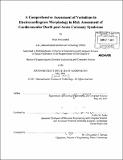| dc.contributor.advisor | Collin M. Stultz. | en_US |
| dc.contributor.author | Parayanthal, Priya | en_US |
| dc.contributor.other | Massachusetts Institute of Technology. Dept. of Electrical Engineering and Computer Science. | en_US |
| dc.date.accessioned | 2011-10-17T21:27:28Z | |
| dc.date.available | 2011-10-17T21:27:28Z | |
| dc.date.copyright | 2011 | en_US |
| dc.date.issued | 2011 | en_US |
| dc.identifier.uri | http://hdl.handle.net/1721.1/66451 | |
| dc.description | Thesis (M. Eng.)--Massachusetts Institute of Technology, Dept. of Electrical Engineering and Computer Science, 2011. | en_US |
| dc.description | Cataloged from PDF version of thesis. | en_US |
| dc.description | Includes bibliographical references (p. 79-82). | en_US |
| dc.description.abstract | Millions of patients worldwide are hospitalized each year due to an acute coronary syndrome (ACS). Patients who have had an acute coronary syndrome are at higher risk for developing future adverse cardiovascular events such as cardiovascular death, congestive heart failure, or a repeat ACS. Currently, there have been several electrocardiographic metrics used to assess the risk of ACS patients for a future cardiovascular death including heart rate variability, heart rate turbulence, deceleration capacity, T-wave alternans, and morphologic variability. This thesis introduces new ECG-based metrics that can be used to risk-stratify post-ACS patients for future cardiovascular death and evaluates the clinical utility of the existing electrocardiogram based metric known as morphologic variability (MV). We first analyze a metric called weighted morphologic variability (WMV) which is based on assessment of beat-to-beat morphology changes in the ECG. In addition, we introduce machine learning methods with morphology based features to separate post-ACS patients into high risk or low risk for cardiovascular death. Finally, we aim to increase the clinical utility of MV by creating a metric that can achieve good risk stratification when applied to a small amount of data. The body of this work suggests that morphologic variability is an effective metric in prognosticating post- ACS patients into high risk and low risk for cardiovascular dearth. | en_US |
| dc.description.statementofresponsibility | by Priya Parayanthal. | en_US |
| dc.format.extent | 86 p. | en_US |
| dc.language.iso | eng | en_US |
| dc.publisher | Massachusetts Institute of Technology | en_US |
| dc.rights | M.I.T. theses are protected by
copyright. They may be viewed from this source for any purpose, but
reproduction or distribution in any format is prohibited without written
permission. See provided URL for inquiries about permission. | en_US |
| dc.rights.uri | http://dspace.mit.edu/handle/1721.1/7582 | en_US |
| dc.subject | Electrical Engineering and Computer Science. | en_US |
| dc.title | A comprehensive assessment of variations in electrocardiogram morphology in risk assessment of cardiovascular death post-acute coronary syndrome | en_US |
| dc.title.alternative | Evolutionary algorithms for compiler-enabled program autotuning | en_US |
| dc.type | Thesis | en_US |
| dc.description.degree | M.Eng. | en_US |
| dc.contributor.department | Massachusetts Institute of Technology. Department of Electrical Engineering and Computer Science | |
| dc.identifier.oclc | 755810955 | en_US |
